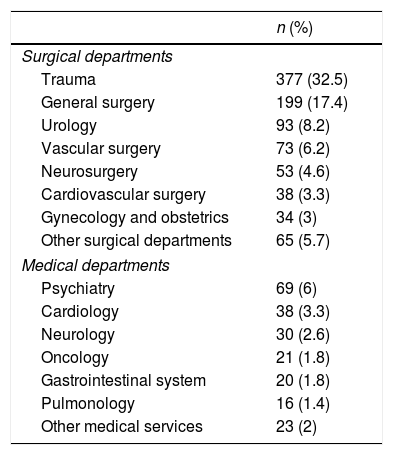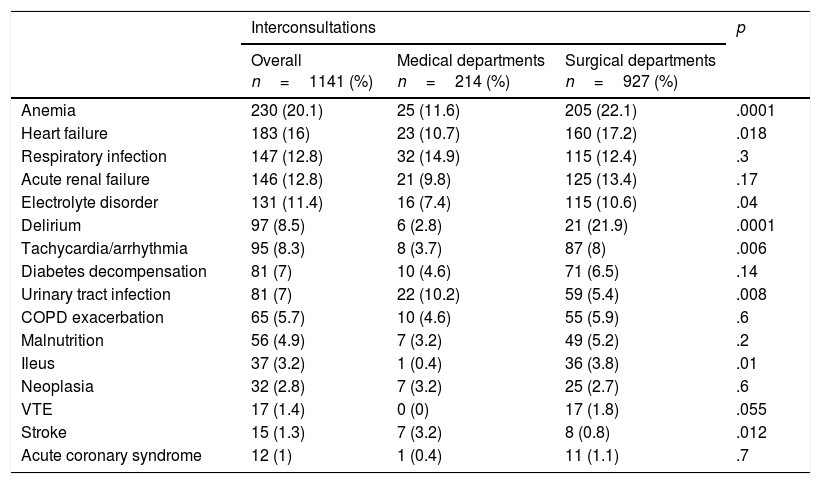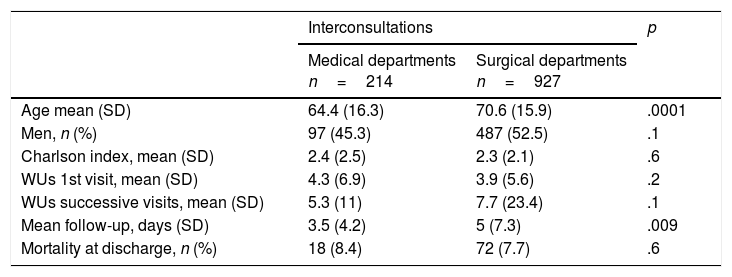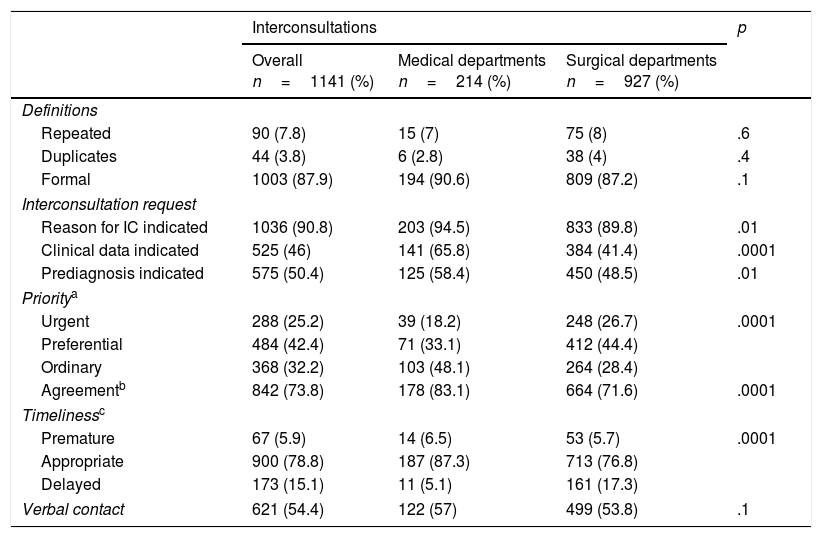To analyze the activity of interconsultations conducted by internal medicine (IM) departments, their formal aspects and the profile of clinical care required and to quantify the workload they represent.
Material and methodA multicentre, observational prospective study was conducted with consecutive hospitalized patients treated by IM departments using interconsultations between May 15 and June 15, 2016. We estimated the workload related to this activity (1time unit [TU]=10min).
ResultsWe recorded 1141 interconsultations from 43 hospitals. The mean age of the patients involved was 69.4 years (SD: 16.2), and 51.2% were men. The mean Charlson index was 2.3 (SD: 2.2). The most common reasons for the consultations were general assessments (27.4%), fever (18.1%), dyspnea (13.6%), metabolic disorder (9.6%), arterial hypertension (6.3%) and delirium (5.3%). The duration of the first visit was 4 TUs (SD: 5.9) and 7.3 (SD: 21.5) for the sum of all subsequent visits. The surgical patients were older (70.6 [SD, 15.9] vs. 64.4 [SD, 16.3] years; p=.0001) and required more follow-up time (5 [SD, 7.3] vs. 3.5 [SD, 4.2] days; p=.009). The following issues were more common in the interconsultation format performed by medical services: number of regular interconsultations (response >24h), specification of the reason for the interconsultation, minimal data regarding the medical history and agreement on the appropriateness of the time spent with the consultant.
ConclusionThe patients treated through interconsultations by the IM departments represented a significant workload. The interconsultations from the medical departments were more in line with the request format.
Analizar la actividad de interconsulta (IC) realizada por los servicios de medicina interna (MI), sus aspectos formales, el perfil de la atención clínica requerida y cuantificar la carga de trabajo que supone.
Material y métodoEstudio multicéntrico, observacional, prospectivo, sobre enfermos consecutivos hospitalizados atendidos por servicios de MI mediante IC entre el 15 de mayo y el 15 de junio del año 2016. Se estimó la carga de trabajo relacionada con dicha actividad (1UT=10min).
ResultadosSe registraron 1.141 IC procedentes de 43 hospitales, edad 69,4 (DE: 16,2) años, 51,2% hombres. El índice de Charlson fue 2,3 (DE: 2,2). Los motivos de consulta más frecuentes fueron: valoración general (27,4%), fiebre (18,1%), disnea (13,6%), trastorno metabólico (9,6%), HTA (6,3%) y síndrome confusional (5,3%). Las UT estimadas fueron 4 (DE: 5,9) para la primera visita y 7,3 (DE: 21,5) para la suma de las sucesivas. Los pacientes quirúrgicos fueron mayores (70,6 [DE: 15,9] vs 64,4 [DE: 16,3]; p=0,0001) y precisaron más días de seguimiento (5 [DE: 7,3] vs 3,5 [DE: 4,2]; p=0,009). Los siguientes aspectos fueron más frecuentes en el formato de las IC realizadas por servicios médicos: número de IC ordinarias (respuesta >24h), especificación del motivo de IC, datos mínimos referentes a la historia clínica y coincidencia de la adecuación en el tiempo con el consultor.
ConclusiónLos pacientes atendidos mediante IC por los servicios de MI representan una carga de trabajo importante. La adecuación al formato de solicitud de IC es mayor en las procedentes de servicios médicos.
Article
Diríjase desde aquí a la web de la >>>FESEMI<<< e inicie sesión mediante el formulario que se encuentra en la barra superior, pulsando sobre el candado.

Una vez autentificado, en la misma web de FESEMI, en el menú superior, elija la opción deseada.

>>>FESEMI<<<










